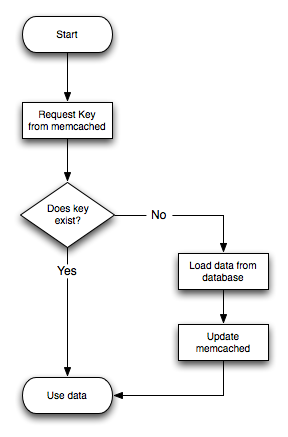- 14.5.3.1. Using
libmemcached - 14.5.3.2. Using MySQL and memcached with Perl
- 14.5.3.3. Using MySQL and memcached with Python
- 14.5.3.4. Using MySQL and memcached with PHP
- 14.5.3.5. Using MySQL and memcached with Ruby
- 14.5.3.6. Using MySQL and memcached with Java
- 14.5.3.7. Using the MySQL memcached UDFs
- 14.5.3.8. memcached Protocol
A number of interfaces from different languages exist for interacting with memcached servers and storing and retrieving information. Interfaces for the most common language platforms including Perl, PHP, Python, Ruby, C and Java.
Data stored into a memcached server is referred to by a single string (the key), with storage into the cache and retrieval from the cache using the key as the reference. The cache therefore operates like a large associative array or hash. It is not possible to structure or otherwise organize the information stored in the cache. If you want to store information in a structured way, you must use 'formatted' keys.
The following tips may be useful to you when using memcached:
The general sequence for using memcached in any language as a caching solution is as follows:
Request the item from the cache.
If the item exists, use the item data.
If the item does not exist, load the data from MySQL, and store the value into the cache. This means the value is available to the next client that requests it from the cache.
For a flow diagram of this sequence, see Figure 14.8, “Typical memcached Application Flowchart”.
The interface to memcached supports the following methods for storing and retrieving information in the cache, and these are consistent across all the different APIs, even though the language specific mechanics may be different:
get(key): Retrieves information from the cache. Returns the value if it exists, orNULL,nil, orundefinedor the closest equivalent in the corresponding language, if the specified key does not exist.set(key, value [, expiry]): Sets the key in the cache to the specified value. Note that this either updates an existing key if it already exists, or adds a new key/value pair if the key doesn't exist. If the expiry time is specified, then the key expires (and is deleted) when the expiry time is reached. The time is specified in seconds, and is taken as a relative time if the value is less than 30 days (30*24*60*60), or an absolute time (epoch) if larger than this value.add(key, value [, expiry]): Adds the key to the cache, if the specified key doesn't already exist.replace(key, value [, expiry]): Replaces thevalueof the specifiedkey, only if the key already exists.delete(key [, time]): Deletes thekeyfrom the cache. If you supply atime, then adding a value with the specifiedkeyis blocked for the specified period.incr(key [, value]): Increments the specifiedkeyby one or the specifiedvalue.decr(key [, value]): Decrements the specifiedkeyby one or the specifiedvalue.flush_all: Invalidates (or expires) all the current items in the cache. Technically they still exist (they are not deleted), but they are silently destroyed the next time you try to access them.
In all implementations, most or all of these functions are duplicated through the corresponding native language interface.
For all languages and interfaces, use memcached to store full items, rather than simply caching single rows of information from the database. For example, when displaying a record about an object (invoice, user history, or blog post), load all the data for the associated entry from the database, and compile it into the internal structure that would normally be required by the application. You then save the complete object into the cache.
Complex data structures cannot be stored directly. Most interfaces
serialize the data for you, that is, put it in a form that can
reconstruct the original pointers and nesting. Perl uses
Storable, PHP uses
serialize, Python uses
cPickle (or Pickle) and Java
uses the Serializable interface. In most cases,
the serialization interface used is customizable. To share data
stored in memcached instances between different
language interfaces, consider using a common serialization
solution such as JSON (Javascript Object Notation).
